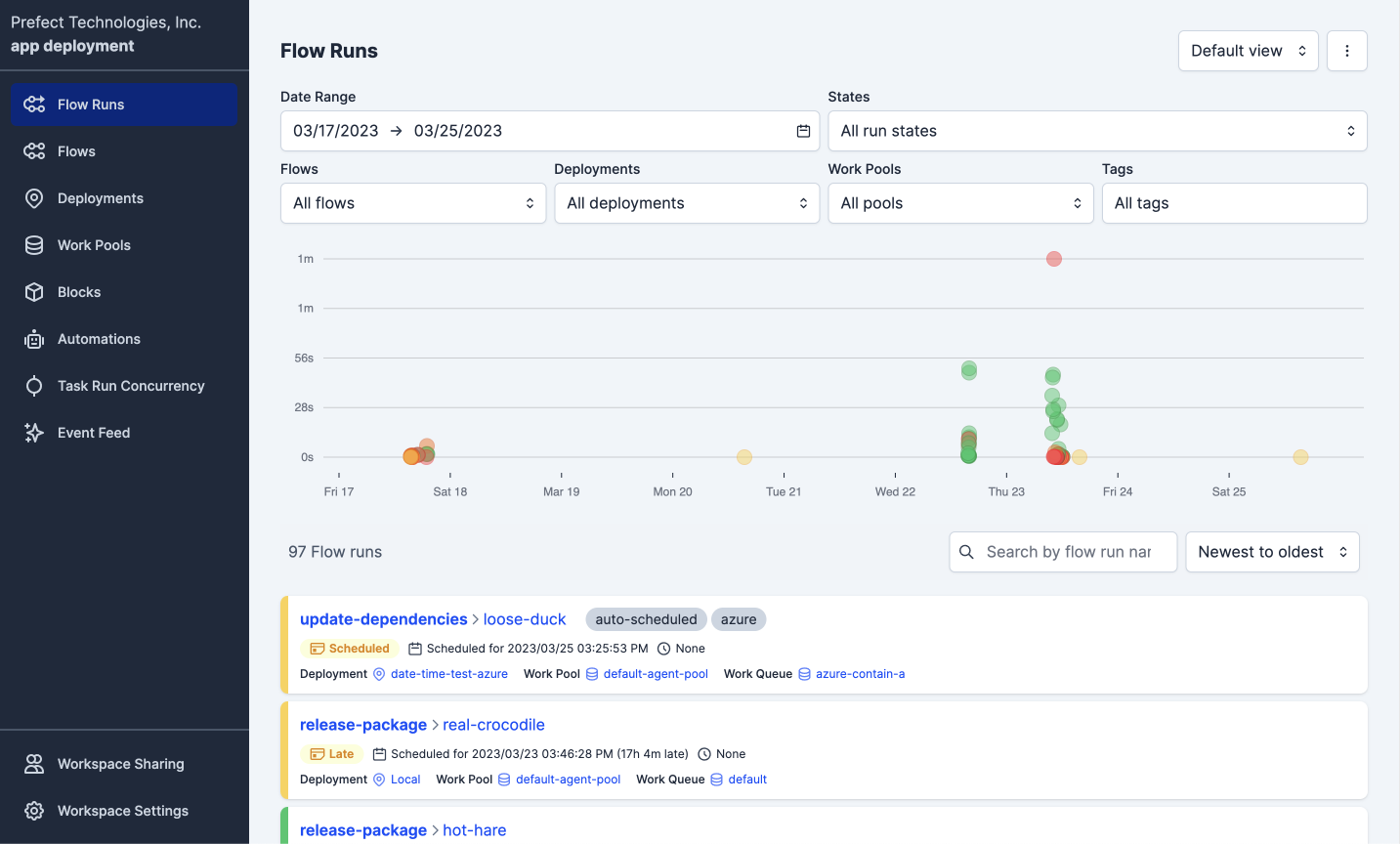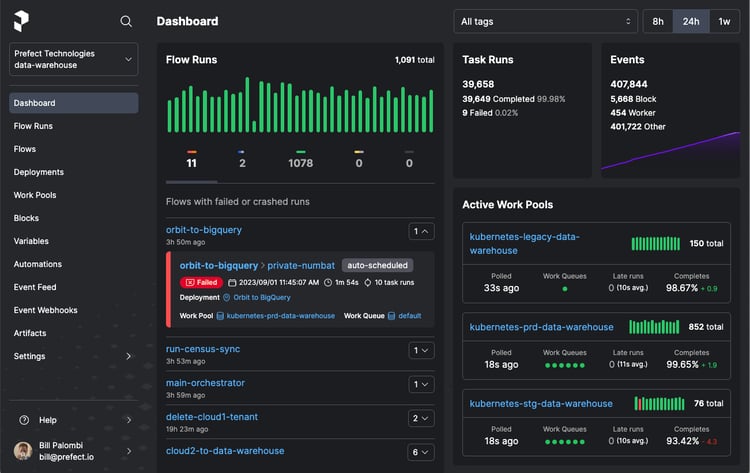Track
As data sources become larger and more complex, efficient and effective ETL processes become more vital. Data engineering workflow orchestration tools serve an important purpose in making the ETL process run smoothly. They allow data engineers to seamlessly combine various data sources, transfer data between data warehouses, and increase the velocity of data as volumes increase.
Orchestration tools such as Prefect and Airflow provide a wide range of options for data engineers to quickly understand the health and effectiveness of their data workflows. Both tools allow for easy deployment, integration with a variety of services, and launch in Python. We will dive into some of their key strengths and weaknesses.
Airflow Overview
Through the usage of DAGs (directed acyclic graphs) and various operators, Airflow is an extremely flexible data workflow orchestrator.
It abstracts many of the necessary functions and allows developers a straightforward introduction to workflow management. It also manages DAGs through the usage of a scheduler and handles workflows through an internally managed database that triggers various workers to process workflows.
Airflow offers a simple web server interface for users to interact with DAGs to trigger, monitor, and halt them as needed to monitor data workstreams.

Example of Airflow interface - source
Prefect Overview
Prefect aims to be a modernized version of Airflow, offering greater dynamic event management and less monolithic dependency infrastructure. It does so by utilizing more Python-driven, minimalistic decorators that allow data engineers to fully construct their own flows.
Prefect focuses on using task and flow decorators to guide development. It also serves its own robust web server for monitoring and debugging. With a Python API approach, it allows developers to test locally, while handling orchestration in the cloud and grants extreme levels of flexibility.

An example of the Prefect interface - source
Key Comparisons Between Airflow and Prefect
Both data workflow tools offer data engineers workflow monitoring, debugging, parallel execution, dependency-based execution, and integration with other data services.
They are both fairly simple to set up, and developers can get simple workflows running very quickly. The user interfaces are intuitive and offer a wealth of information about the health of processes, including current status, run-time, failures, and historical run information.
Ease of use
Both options provide simple-to-understand interfaces that give solid overviews of data workflow health alongside key data management control. However, the ease a developer will have when building these workflows differs between tools.
- Prefect features more modern and robust interfaces that provides overall system stats such as events, completion rates, active work pools, and failures in an easy-to-read dashboard.
- Prefect picks a more modern aesthetic showcasing its monitoring and event management with a look akin to a Gantt chart.
- Airflow’s interface lists all DAGs with icons stating their status. Within this interface, Airflow’s DAG appearance is more minimalistic, focusing on the flow, and clearly showcasing the connection between different nodes.
- Both are quite similar in set-up time, involving the installation of a few Python packages to get started.
- Prefect uses an API-based foundation, while Airflow uses operator modules.
Scalability
Both tools are designed to scale rapidly and easily.
- Prefect scales well if you offload to the cloud. Local management of orchestration is possible, but execution of tasks requires larger scales of computing power that may not be available on your local machine.
- Airflow scales based on the resources available and will almost always run on a remote machine. As workflows scale, Airflow will require more memory, so systems need to be more robust to handle bandwidth and data processing.
Flexibility
Both orchestration tools offer similar levels of flexibility. They integrate with a variety of data sources and come with their own tools, such as sensors, event handlers, and monitoring.
- Both offer seamless integration and connectors to major data services such as GCP, AWS, and Azure.
- Airflow utilizes operators, which provide key functions to connect with data sources.
- Prefect uses blocks, tasks, and flows, which allow you to create the components necessary to connect with data sources.
Monitoring and logging
Monitoring the health of your workflow can be challenging at scale. These monitors alert data engineers of issues with the pipeline or the data. Ideally, they are able to stop the flow of data before it impacts production pipelines and offer clear warnings about the issue.
- Prefect’s monitoring is more sophisticated than Airflow, offering more built-in and native logging.
- Prefect has better event management and the ability to handle dynamic orchestration through the subscription of existing event systems.
- Airflow’s logging needs to be built entirely by the developer.
- Airflow has sensor operators, which can monitor external tasks such as file uploads but it struggles to react dynamically to changing data states and updates.
- Prefect is simpler when it comes to error-handling development as it has flexible modules for a variety of problems.
- Within Airflow, many of these monitoring and sensory tools need to be put together by the developer through a combination of different operators.
Prefect vs Airflow: A Comparison
Below, you can find a table summarizing the key differences between Airflow and Prefect:
|
Prefect |
Airflow |
|
|
Ease of Use |
UI is straightforward, with deployment a breeze using API-based objects |
UI is minimalistic, with deployment focusing on operators and DAG construction |
|
Scalability |
Highly scalable and can be incorporated into Prefect Cloud |
Requires scaling of hardware |
|
Flexibility |
Very flexible due to its blocks integrating with other data sources |
Operators offer abstractions that allow for easy connections to other data sources |
|
Monitoring and Logging |
Modern, dynamic event-management |
Logging must be constructed manually |
|
Community and Support |
Newer and less community support |
Older, lots of community support and development |
Airflow Use Cases
Overall, Airflow offers a robust orchestration solution. Its setup is simplified by using operators and easy-to-outline DAGs.
Airflow users explicitly define DAGs by defining the variables and coding them out.
- Airflow excels in its directness and is great for primarily static data flow.
- Great solution for teams looking for a streamlined approach to getting data from point A to point B with some ETL in the middle.
- There is less complexity than with Prefect. Teams can get up and running with minimal developer time and create beautifully complex networks.
Prefect Use Cases
Prefect offers a powerful, modern, and highly dynamic workflow orchestration tool. It focuses on using Pythonic development with an API-focused syntax and generating subflows by creating functions within functions.
- This is the perfect tool for a seasoned data engineering team looking to increase the robustness of their workflow management.
- It’s great for teams that need high levels of monitoring and highly dynamic interactions with data sources.
- Lack of a large community may make troubleshooting issues challenging, but Prefect’s documentation is quite extensive.
Performance expectations
Understanding the performance of each is vital. Both can grind to a halt if not implemented properly. Focus on offloading execution to other services will allow your orchestration tool to do what it does best: orchestrate.
That being said, expect to utilize a healthy amount of memory and bandwidth if hoping to run multiple processes in parallel for both Airflow and Prefect. Anecdotally, Airflow is noted as being a little slower than Prefect, but overall performance is similar.
Prefect vs Airflow: Which to Choose
The world of data management is complex. Consider your team’s individual needs and find the balance that suits them best.
Workflow orchestration will continue to evolve.
Choose Airflow for a simpler, minimalistic approach to orchestration with a focus on getting data from point A to point B as quickly as possible.
Choose Prefect for a more hardy system which will hum with developers comfortable with a Python-based API.
To really get a good feel for the tools, it’s best to jump in and get some practice. Here are some resources to get started:
- A great introductory Airflow tutorial
- Follow this Prefect tutorial for machine learning workflows for a quick start in Prefect
- Check out other top MLOps tools to expand your knowledge
I am a data scientist with experience in spatial analysis, machine learning, and data pipelines. I have worked with GCP, Hadoop, Hive, Snowflake, Airflow, and other data science/engineering processes.





